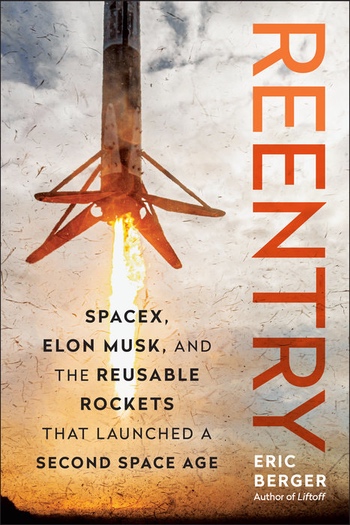Review: Reentryby Jeff Foust
|
| Interviews with dozens of people who worked at SpaceX, and others who worked with it, tell the story of the rise of the company as it overcame many technical challenges in the development of new rockets and spacecraft. |
On Sunday, SpaceX launched its fifth integrated Starship/Super Heavy vehicle from its Starbase site at Boca Chica, Texas. The Starship upper stage flew what appeared to be a successful suborbital mission, making a powered “landing” on target in the Indian Ocean before breaking up and exploding. More remarkably, though, the Super Heavy booster flew back to the launch site, making a precise return to the launch tower where two mechanical arms “caught” the booster: a technical feat that won widespread acclaim and an essential step in the company’s plans for rapid reuse of the vehicle.
And, on Monday, a Falcon Heavy lifted off from the Kennedy Space Center, sending NASA’s $5 billion Europa Clipper mission on its way. The launch illustrated the level of dependence that government and industry have on SpaceX: once NASA concluded (and Congress agreed) that SLS could not launch Europa Clipper without potentially shaking the spacecraft apart, Falcon Heavy was the only real option with the retirement of the Delta IV Heavy and delays in introduction of new vehicles. Still, the $178 million NASA spent on the Falcon Heavy launch was less than a tenth of the estimated cost of a single SLS.
Just a decade ago, all those technical and marketplace achievements would have seemed unlikely. SpaceX was still something of an upstart, working to slowly get the Falcon 9 flying on a regular basis while filing a lawsuit against the Air Force to break open a military launch market that United Launch Alliance had locked up. It had a NASA contract for Dragon cargo missions to the International Space Station but was seen as an underdog to Boeing for a commercial crew award.
How the company got to its current place of dominance in the space market is the subject of Reentry by Eric Berger, a sequel to his 2021 book Liftoff about the early years of SpaceX when the company was struggling to launch the Falcon 1 (see “Review: Liftoff”, The Space Review, March 1, 2021.) In Reentry, he recounts the development of Falcon 9, Dragon, Crew Dragon, and more that turned the company from a startup just trying to survive into the space industry giant it is today.
Like in Liftoff, Berger uses interviews with dozens of people who worked at SpaceX, and others who worked with it, to tell the story of the rise of the company as it overcame many technical challenges in the development of new rockets and spacecraft. That creates a book rich in entertaining anecdotes about those efforts. A few are well known, like the technician called in to snip off the bottom of the nozzle on the Merlin upper stage engine after a crack was found just before the Falcon 9’s inaugural launch, but most were not public before this book came out.
The driving force behind the company’s rise, and many of the anecdotes in the book, is Elon Musk. He is the central character in the book, but one at some remove: Berger notes that he had less access to Musk for Reentry than his earlier book, with Musk expressing an interest to participate in interviews only to cancel them. The interviews with others, though, and past talks with Musk illustrate how he has managed the company, pushing people to go faster or do more for less money. The result, the book concludes, is that SpaceX will do things faster or cheaper than anyone else in the industry, but still not as fast or as cheap as Musk wants.
That has made the company a success, although it is an approach that inevitably burns out even its most dedicated employees. “After two decades, the company has not lost its founder’s mentality,” Berger writes in the book’s epilogue. “As most companies grow, they lose the founder’s mentality, their hunger, their insurgency. But not SpaceX.”
| After two decades, the company has not lost its founder’s mentality,” Berger writes. “As most companies grow, they lose the founder’s mentality, their hunger, their insurgency. But not SpaceX.” |
That is evident today as SpaceX presses ahead with Starship and its Starlink constellation. (The early development of both is recounted in the book, although more recent progress is understandably missing given the timelines of book publishing.) Both are ambitious, but Musk has far grander plans for both.
With that founder’s mentality in place, Berger concludes there are few competitive threats to SpaceX today, even as companies field new launch vehicles or propose new satellite systems. (Berger suggests that Blue Origin founder Jeff Bezos buy Rocket Lab and “empower” its founder, Peter Beck: “That has the best chance of molding Blue Origin into a true SpaceX competitor.”) The biggest threat to SpaceX, he concludes, is the company itself, a fall that could be precipitated by Musk’s acquisition of Twitter (now X) and the attention he devotes to that and, more broadly, politics. That has only grown in recent months, long after the book went to press, with Musk’s endorsement of Donald Trump and advocacy of him and right-wing causes on X, which now includes a political action committee.
Musk, he concludes, “must remain an agency of change and disruption, while not becoming an agent of chaos and distraction.” That change and disruption shaped SpaceX and, with it, the broader space industry, which continues today with Starship and Starlink. How long that can continue will have huge ramifications not just for SpaceX, but for the future of spaceflight.
Note: we are now moderating comments. There will be a delay in posting comments and no guarantee that all submitted comments will be posted.
